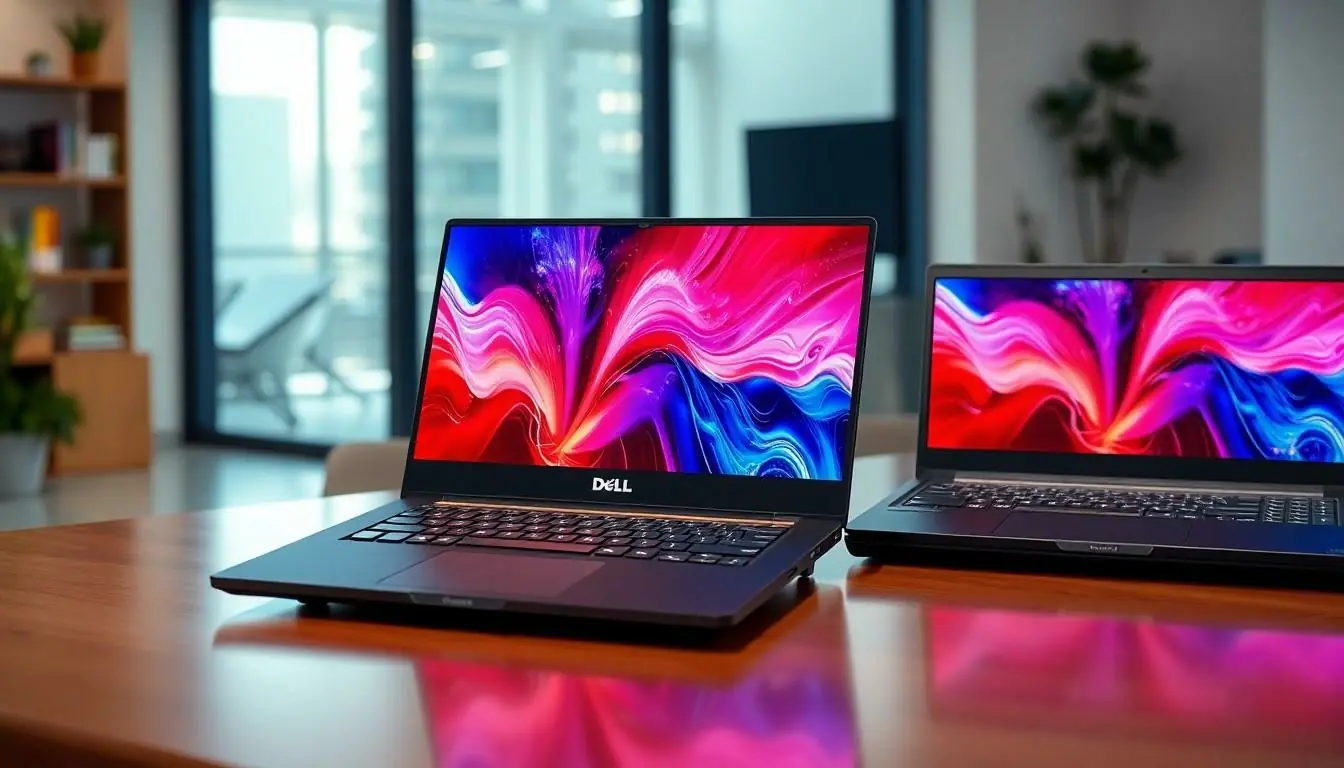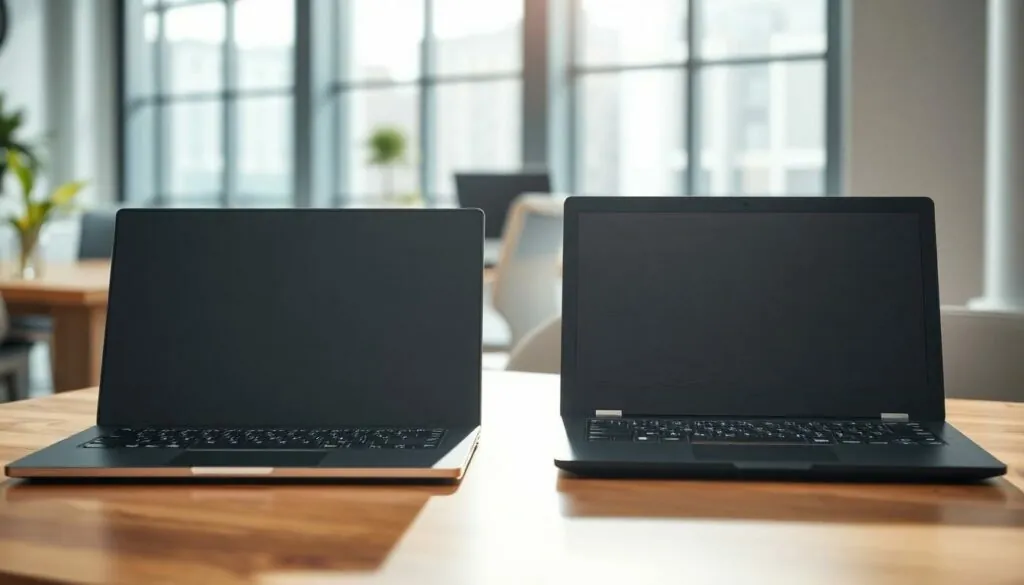Table of Contents
ToggleWhen it comes to choosing a laptop, the battle of Dell vs Lenovo often leaves tech enthusiasts in a bit of a pickle. Both brands have their loyal fanbases, and each claims to have the best slice of the computing pie. But how do you decide which one’s the right fit for you?
Picture this: Dell’s sleek designs and reliable performance versus Lenovo’s innovative features and legendary keyboards. It’s like choosing between a classic rock band and a cutting-edge DJ. Each has its charm, but which one will keep you dancing through your workday? Buckle up as we dive into the nitty-gritty of these two titans to help you find the laptop that’ll make you wonder how you ever lived without it.
Overview of Dell vs Lenovo Laptops
Dell laptops are known for their sleek designs and solid performance, appealing to professionals and gamers alike. Reliability remains a key factor, with many users praising Dell’s robust build quality. Lenovo stands out with innovative features, particularly in their Yoga and ThinkPad series, which excel in versatility.
Battery life often becomes a deciding factor for travelers. Dell typically offers competitive battery longevity, ensuring users stay powered throughout the day. Lenovo’s laptops sometimes provide even longer battery life, catering to those who prioritize extended mobile usage.
When it comes to keyboards, Lenovo’s reputation shines. Users frequently report that Lenovo’s ergonomic keyboards enhance typing comfort and speed, making them a top choice for writers and programmers. Dell does offer quality keyboards, but they generally don’t receive the same acclaim as Lenovo’s.
Display quality also plays a significant role in preference. Dell’s XPS line features stunning high-resolution displays, ideal for creators needing accurate color representation. Lenovo’s displays, particularly in their higher-end models, provide excellent clarity and brightness, suitable for both work and entertainment.
Price varies between both brands, with Dell often positioning its premium models higher than Lenovo. Lenovo tends to deliver more budget-friendly options without sacrificing essential features. Users seeking value may find Lenovo a preferable choice.
Customer support feedback can influence buying decisions. Dell’s support is generally rated as reliable, but Lenovo also garners praise for its responsiveness. Potential buyers often weigh these factors alongside other specifications to make informed choices.
Performance Comparison

Performance plays a key role in the decision-making process between Dell and Lenovo laptops. Each brand presents unique advantages based on specific requirements.
Processor Options
Dell offers a variety of processors, including Intel’s latest Core i5 and i7 options suited for demanding applications. Lenovo, on the other hand, provides AMD Ryzen processors alongside Intel options, catering to a wider audience. Performance metrics indicate that Intel processors, particularly in Dell’s XPS line, excel in multitasking capabilities. Ryzen processors from Lenovo deliver impressive performance in parallel tasks. Both brands enhance processing power, but choices depend on user needs, whether for gaming, video editing, or office productivity.
Graphics Performance
Dell typically integrates NVIDIA GeForce graphics cards in its gaming laptops, offering superior performance for graphics-intensive tasks. Conversely, Lenovo features options for both NVIDIA and AMD graphics, allowing flexibility based on budget and requirements. Benchmarks show Dell’s graphics performance shines in gaming scenarios. Lenovo laptops also perform well for casual gaming and creative work, but performance varies by model. Users seeking high-resolution gaming experiences might prefer Dell, while those valuing versatility may opt for Lenovo’s offerings.
Design & Build Quality
The design and build quality of laptops significantly impact user satisfaction and usability. Both Dell and Lenovo focus on durable materials and impressive aesthetics.
Aesthetics and Materials
Dell laptops often feature a sleek aluminum chassis that exudes sophistication. Many users appreciate the high-quality finishes, particularly in models like the XPS series. Lenovo, on the other hand, offers a mix of matte and glossy finishes, attracting attention with its innovative designs. The ThinkPad line is well-known for its sturdy plastic and carbon-fiber materials, giving it a professional look that appeals to business users. Each brand prioritizes elegance while ensuring their build quality stands the test of time.
Portability and Weight
In terms of portability, Dell laptops generally weigh around 2.5 to 4.5 pounds, making them suitable for travel. Most models, particularly ultrabooks, emphasize lightweight designs, facilitating easy transport. Lenovo’s Yoga series often weighs about 2.5 to 3.5 pounds, providing similar portability advantages. Compact designs are prominent in both brands, with Dell focusing on slim profiles and Lenovo offering versatile convertibles. Users seeking portability appreciate that both brands present options that balance weight and functionality.
Battery Life
Battery life is a crucial aspect of laptop performance, especially for users on the go. Both Dell and Lenovo offer competitive battery options.
Dell Laptop Battery Performance
Dell laptops generally feature impressive battery efficiency, particularly in the XPS series. Users can expect around 10 to 15 hours of use, depending on model specifications and usage patterns. Equipped with adaptive battery technology, some models manage power consumption effectively. Professionals and gamers often appreciate the balance of power and longevity Dell delivers. Reports indicate that the high-resolution displays in devices like the XPS can impact battery life, yet they’ve optimized performance to minimize this.
Lenovo Laptop Battery Performance
Lenovo laptops often excel in battery longevity, with some Yoga and ThinkPad models achieving up to 20 hours on a full charge. This durability appeals to business professionals and students who require reliable performance during long days. Incorporating advanced power management features enhances the overall efficiency. Data from user reviews frequently highlight Lenovo’s ability to combine battery life with quick charge capabilities. Many users find this to be particularly helpful in fast-paced environments where time matters.
Pricing and Value
Pricing and value are crucial in comparing Dell and Lenovo laptops. Both brands cater to diverse budgets while ensuring quality and performance.
Entry-Level Options
Dell’s entry-level laptops typically start at around $400. These models, like the Inspiron series, provide essential features for everyday tasks. Lenovo also offers value-driven options, such as the IdeaPad series, priced similarly. These devices often excel in affordability and decent performance for students and casual users. Lenovo focuses on providing features such as solid battery life and comfortable keyboards in this range. Brands balance cost with performance, aiming to attract budget-conscious shoppers who require reliable machines.
Premium Models
Dell’s premium laptops often range from $1,200 to over $2,000, particularly in the XPS series. These laptops prioritize cutting-edge technology and design, appealing to professionals and creators. In contrast, Lenovo’s ThinkPad X1 Carbon typically starts around $1,400. Lenovo emphasizes features such as excellent build quality and impressive keyboard ergonomics. Both brands compete heavily in this segment, with high-resolution displays and advanced processors. Customers seek exceptional performance and usability in this price range, making the investment worthwhile for demanding applications.
Choosing between Dell and Lenovo laptops ultimately depends on individual needs and preferences. Dell stands out for its sleek designs and robust performance, making it an excellent choice for professionals and gamers alike. On the other hand, Lenovo offers innovative features and ergonomic keyboards that cater to writers and programmers, along with impressive battery life.
Both brands provide a range of options across various price points, ensuring there’s something for everyone. Whether prioritizing build quality, display excellence, or customer support, users can confidently select a laptop that aligns with their requirements. The right choice will enhance productivity and provide a satisfying user experience.

